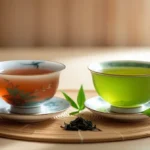Table of Contents
Welcome to the cozy world of genmaicha japanese tea with roasted rice, a harmonious blend that brings together the fresh taste of green tea with the comforting aroma of roasted rice. It’s a unique blend that’s become a favorite for many, offering a flavor profile that’s both familiar and exciting. Whether you’re new to tea or a seasoned drinker, Genmaicha offers a delightful experience that’s easy to enjoy.
Key Takeaways
- Genmaicha is a Japanese tea made by combining green tea leaves with roasted brown rice.
- The roasted rice gives Genmaicha a distinctive nutty flavor and a warm, toasty aroma.
- Brewing Genmaicha involves using water around 80-85°C (176-185°F) and steeping for about one minute.
- Variations like Matcha-iri Genmaicha and blends with black soybeans offer different taste experiences.
- Genmaicha offers a unique flavor and aroma compared to other Japanese teas like Sencha and Matcha, often with a milder taste and less caffeine.
Understanding Genmaicha Japanese Tea with Roasted Rice
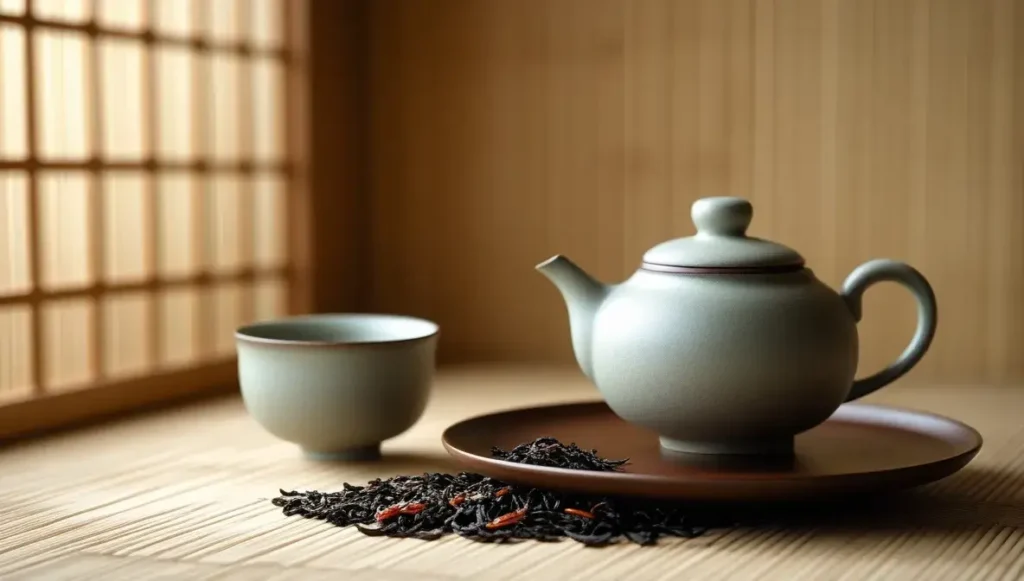
Let’s talk about genmaicha, a really interesting Japanese tea. If you’ve ever wondered what is genmaicha, it’s basically a blend of green tea leaves and roasted rice. It’s sometimes called “japanese roasted rice tea” or even “popcorn tea” because some of the rice grains can actually pop when they’re roasted, kind of like popcorn. This isn’t just some random addition; the roasted rice plays a big part in what makes this drink so special.
What is Genmaicha?
Genmaicha is a popular Japanese green tea that stands out because it includes roasted rice. Think of it as a marriage between the fresh, sometimes grassy notes of green tea, like sencha or bancha, and the warm, nutty aroma of toasted rice. It’s a combination that’s been around for a while, originally becoming popular because the rice made the tea more affordable, earning it the nickname “people’s tea.” So, when you hear “what is genmaicha tea,” remember it’s that unique mix of green tea and roasted grains.
The Role of Roasted Rice in Genmaicha
The roasted rice in genmaicha isn’t just for show or to stretch the tea leaves. It really changes the whole experience. It adds a comforting, toasty smell and a flavor that’s a bit nutty and savory, almost like toasted bread or popcorn. This mellows out the sometimes sharp or vegetal taste of the green tea, making it smoother and easier to drink for a lot of people. It’s this balance that makes genmaicha a favorite for many, offering a comforting cup that’s both familiar and unique. It’s a key part of what makes this japanese green tea with rice so distinct.
The Unique Flavor Profile of Genmaicha
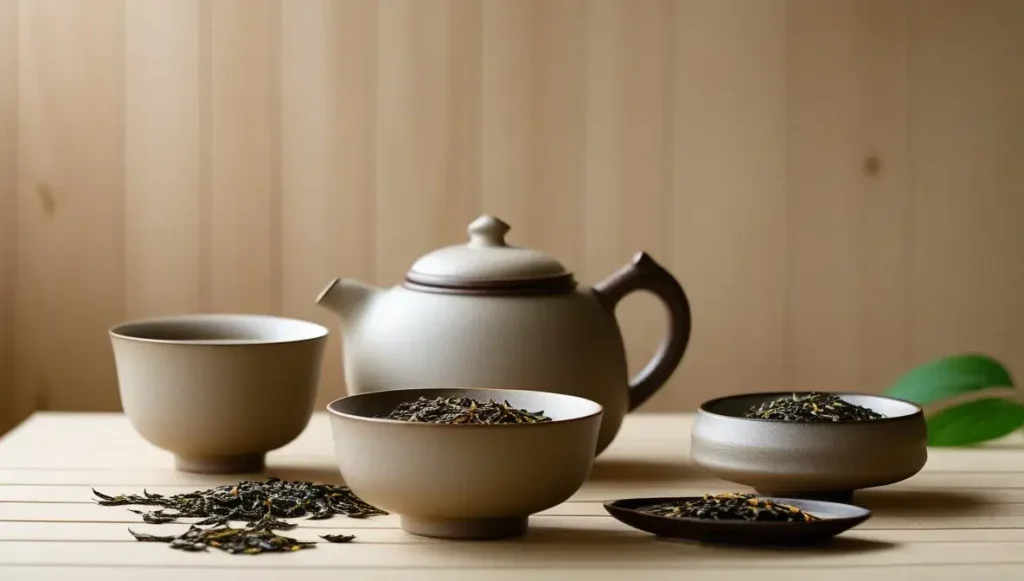
When you first try genmaicha, you’ll notice it’s quite different from other green teas. The flavor profile of genmaicha is really what makes it special. It’s this interesting mix of the fresh, sometimes grassy taste of green tea leaves and the warm, nutty notes from the roasted rice. Think of it like a comforting hug in a mug, but with that familiar green tea zing. The rice isn’t just filler; it really changes the whole experience.
How Roasted Rice Influences Genmaicha’s Aroma and Taste
The roasted rice is the star here, really. It gives genmaicha its signature toasty aroma, almost like popcorn or toasted bread. This smell is super inviting. Taste-wise, the rice mellows out the sometimes sharp or bitter notes you can get from green tea. Instead, you get this smooth, slightly sweet, and nutty flavor that’s really easy to drink. It’s a gentler introduction to green tea for many people.
Common Flavor Notes in Genmaicha Tea
So, what exactly does it taste like? You’ll often find notes of toasted nuts, a bit of sweetness, and that characteristic popcorn-like flavor from the rice. The green tea base adds a subtle vegetal or grassy undertone, but it’s usually not overpowering. The overall impression is balanced and comforting. It’s not a tea that shouts; it’s more of a gentle hum.
Flavor Profile Enhanced by Roasted Rice and Popped Grains
Sometimes, the rice in genmaicha is actually popped, like popcorn. This popping process really brings out the nutty and toasty qualities even more. It adds a bit of texture and a deeper, more complex flavor to the brew. The combination of the green tea and these toasted, sometimes popped grains creates a unique genmaicha flavor profile that’s both familiar and exciting. It’s a really satisfying cup, whether you’re drinking it with food or just on its own.
👉 Enjoy Authentic Genmaicha With Premium Roasted Rice Now 👈
Brewing the Perfect Cup of Genmaicha
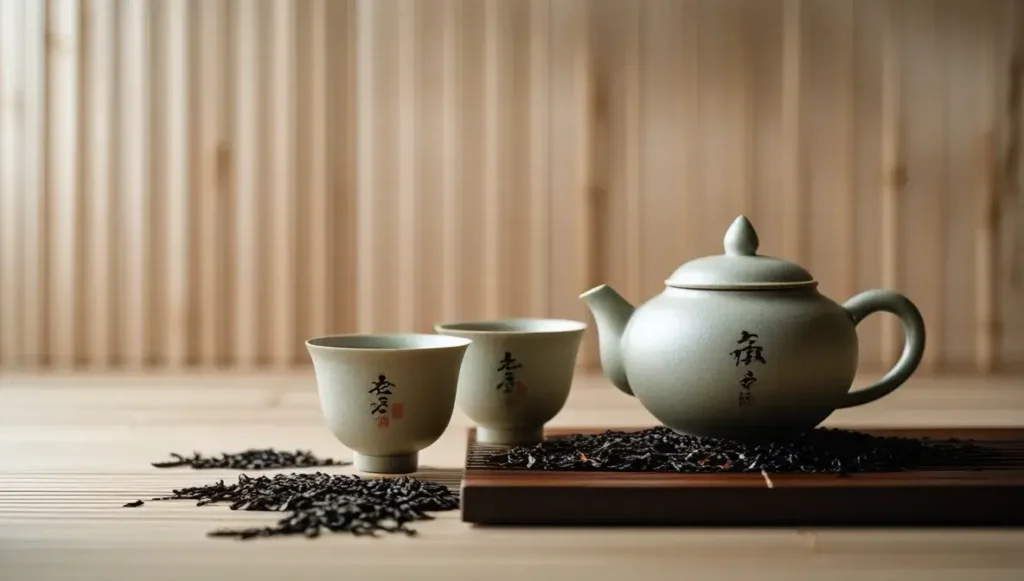
Brewing Genmaicha is pretty straightforward, but there are a few things that make a big difference in how it turns out. It’s not complicated, but paying attention to the details helps you get the most out of that toasty, nutty flavor. If you’re wondering how to brew genmaicha or the best way to drink genmaicha, you’ve come to the right place.
Measure Your Ingredients
First off, you need to get the amounts right. A good starting point for how to brew green tea with rice is about one tablespoon of the Genmaicha blend for every 6 to 8 ounces of water. This ratio gives you a nice balance between the green tea’s natural grassy notes and the comforting aroma of the roasted rice. You can tweak this later, of course, if you like it stronger or milder.
Heat the Water
This is super important. You don’t want to use boiling water for Genmaicha, or any green tea for that matter. Boiling water can scorch the delicate tea leaves, making your brew taste bitter. Aim for water that’s around 175°F to 185°F (80°C to 85°C). If you don’t have a thermometer, just bring the water to a boil and then let it sit for a minute or two. It’s a small step, but it really makes a difference.
Steep the Tea
Now for the steeping part. Pour your heated water over the Genmaicha leaves and rice. For the first infusion, about 30 seconds to a minute is usually perfect. Some people like to go a little longer, but be careful not to over-steep, or you might get that bitterness we talked about. The goal is to coax out the flavors, not to force them.
Enjoy Your Brew
Once it’s steeped, strain the tea leaves and rice out. Pour it into your favorite mug or teacup. Take a moment to smell that wonderful toasty aroma before you take your first sip. It’s a really comforting drink, and the roasted rice adds a unique character that you just don’t get with other green teas. It’s a simple pleasure, but a really satisfying one.
Exploring Genmaicha Variations
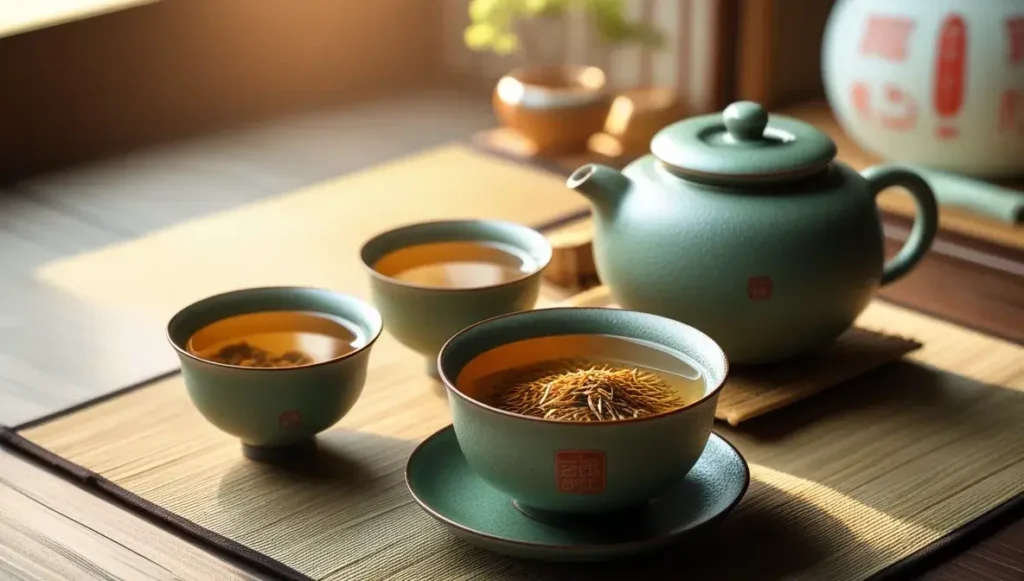
Genmaicha is a wonderfully approachable Japanese tea, and part of its charm comes from the variations you can find. It’s not just one single thing, you know? Depending on what you’re looking for, there are a few ways it gets mixed up.
Matcha-iri Genmaicha
This is a pretty popular twist. Basically, they add powdered matcha to the standard genmaicha blend. It gives the tea a bit more color, a richer flavor, and an extra kick of that matcha goodness. If you like genmaicha but want something a little more intense, this is definitely worth trying. It’s like the original genmaicha got a fancy upgrade.
Genmaicha with Black Soybeans
Another interesting variation uses roasted black soybeans instead of, or sometimes in addition to, the rice. This gives the tea a different kind of nutty flavor, often a bit deeper and earthier than the rice version. It’s a nice change of pace if you’re a fan of genmaicha and want to explore different taste profiles. Some people find the soybeans add a subtle sweetness too.
Creating Original Genmaicha Blends
Don’t be afraid to experiment yourself! You can buy plain green tea and roasted rice separately. Then, you can mix them to your own liking. Want more rice? Go for it. Want just a hint of roasted flavor? Easy. You can even try adding other things, like a few toasted barley grains or even some dried herbs, though that’s getting pretty far from traditional genmaicha. It’s a fun way to discover what you like best. Finding the best genmaicha brands is a good starting point, but making your own blend can be really rewarding.
👉 Taste the Premium Genmaicha Green Tea With Roasted Rice 👈
Genmaicha’s Distinctive Qualities

Genmaicha really stands out when you look at it next to other teas. It’s not just another green tea; the addition of roasted rice gives it a whole different personality. This blend creates a comforting and approachable flavor that many people find really appealing. It’s a tea that feels both familiar and a little bit special.
Aroma: From Toasty to Nutty Notes
The smell of Genmaicha is one of its most defining features. When you open a bag or brew a cup, you’ll immediately notice the warm, toasty scent from the roasted rice. It’s not overpowering, but it’s definitely there, mingling with the lighter, sometimes grassy notes of the green tea leaves. This combination makes the aroma feel cozy and inviting, like freshly baked bread or toasted nuts. It’s a scent that really sets the mood for a relaxing tea break.
How Genmaicha Differs from Other Teas Like Sencha and Matcha
When you compare Genmaicha to other popular Japanese teas, its uniqueness becomes even clearer. Take Sencha, for example. Sencha is a classic green tea, known for its fresh, sometimes slightly vegetal or oceanic flavor. It’s pure green tea, and while delicious, it doesn’t have that warm, toasty element. Genmaicha, on the other hand, takes that green tea base and adds the roasted rice, which softens the green tea’s sharper edges and introduces that nutty, comforting taste. It’s a gentler experience overall.
Then there’s Matcha. Matcha is a powdered green tea, and it’s known for its vibrant green color and intense, rich flavor. It has a higher caffeine content and a more robust, sometimes bitter taste. While you can find Genmaicha blended with Matcha (Matcha-iri Genmaicha), plain Genmaicha is much milder. The roasted rice in Genmaicha makes it less intense than Matcha, offering a smoother, more mellow cup. It’s less about a strong, concentrated flavor and more about a balanced, comforting profile.
The roasted rice doesn’t just add flavor; it also affects the tea’s body and mouthfeel, making it feel a bit fuller and smoother compared to a pure green tea like Sencha.
The Unique Benefits of Roasted Rice in Genmaicha
Nutritional Contributions of Roasted Rice
So, what’s the deal with the rice in genmaicha? It’s not just for show! The roasted rice in this green tea with rice adds a few things to the party. Think of it as a little bonus. While it doesn’t drastically change the calorie count, it does bring some B vitamins and minerals. These are the sorts of things that help your body work, like turning food into energy. It’s a subtle addition, but it’s there, contributing to the overall makeup of the drink. It’s a nice little something extra you get from your cup of genmaicha.
Digestive and Calming Effects
One of the really nice things about genmaicha tea benefits is how it can feel on your stomach. The roasted rice is often said to be easier on the digestive system compared to just plain green tea. Some people find that drinking genmaicha, especially after a meal, helps them feel more settled. It’s like the rice acts as a gentle buffer.
Plus, there’s something about that toasty, nutty aroma from the roasted rice that just feels comforting. It’s not a strong sedative or anything, but that warm scent can contribute to a feeling of calm. It’s one of those toasted rice tea benefits that people really appreciate when they’re looking for a relaxing beverage. The combination of the green tea’s natural compounds and the mellowing effect of the rice makes for a really pleasant drinking experience. It’s a big part of why genmaicha tea benefits are so talked about.
The roasted rice in genmaicha is more than just a filler; it’s a key component that shapes the tea’s character, making it approachable and comforting. It smooths out the sharper notes of the green tea, creating a balanced flavor profile that’s both satisfying and easy to enjoy.
Wrapping Up Your Genmaicha Journey
So, there you have it. Genmaicha is a pretty neat tea, right? It’s got that comforting roasted rice flavor mixed with the green tea, making it a go-to for a lot of people. Whether you’re just starting out or you’ve been drinking it for years, there’s always something new to discover with this tea. Don’t be afraid to play around with how you brew it – maybe a little more or less rice, or a slightly different water temperature. Finding your perfect cup is part of the fun. Give it another try, maybe share a cup with a friend, and just enjoy that unique taste and smell. It’s a simple pleasure that really can brighten your day.
👉 Grab This Top-Rated Genmaicha Tea Before It’s Gone 👈
Frequently Asked Questions
What exactly is Genmaicha tea?
Genmaicha is a Japanese tea made by mixing green tea leaves with roasted brown rice. Sometimes, the rice is even popped like popcorn, giving it a fun texture and a toasty flavor.
How does the roasted rice change the taste and smell of Genmaicha?
The roasted rice gives Genmaicha its special flavor! It adds a warm, nutty taste, kind of like popcorn or toast, which balances out the grassy taste of the green tea. It makes the tea smell really nice and toasty, too.
What’s the best way to brew Genmaicha?
To make a great cup, use about one tablespoon of Genmaicha for every cup of water. Heat fresh water until it’s hot but not boiling, around 175-185°F (80-85°C), to avoid making the green tea taste bitter. Let it steep for about one minute, then strain and enjoy!
How is Genmaicha different from other Japanese teas like Sencha or Matcha?
Genmaicha is different because of the roasted rice. Unlike plain Sencha, it has that nutty, toasty flavor from the rice. It’s also usually milder and has less caffeine than Matcha, offering a more comforting and less intense taste.
Are there different kinds of Genmaicha, or can I make my own?
Yes, you can! You can mix Matcha powder with Genmaicha for a richer flavor and color, or add black soybeans for extra nutrition and a nice look. You can even mix different teas with Genmaicha at home to create your own unique blends.
What are the benefits of the roasted rice in Genmaicha?
Roasted rice can add some vitamins and minerals to your tea. It’s also thought to help with digestion and can have a calming effect, making it a nice drink after meals or when you want to relax.
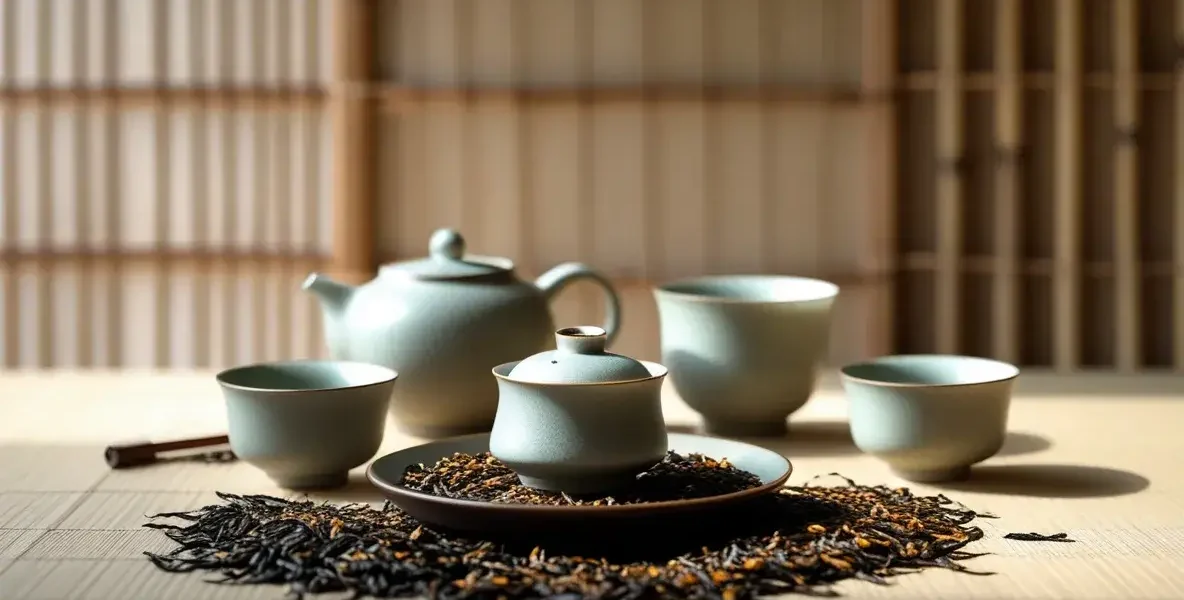





![Jasmine Tea vs Green Tea Benefits: Which Gives Better Health Results? [2025] jasmine tea vs green tea benefits](https://www.goteaworld.com/wp-content/uploads/2025/09/jasmine-tea-vs-green-tea-benefits-150x150.webp)


